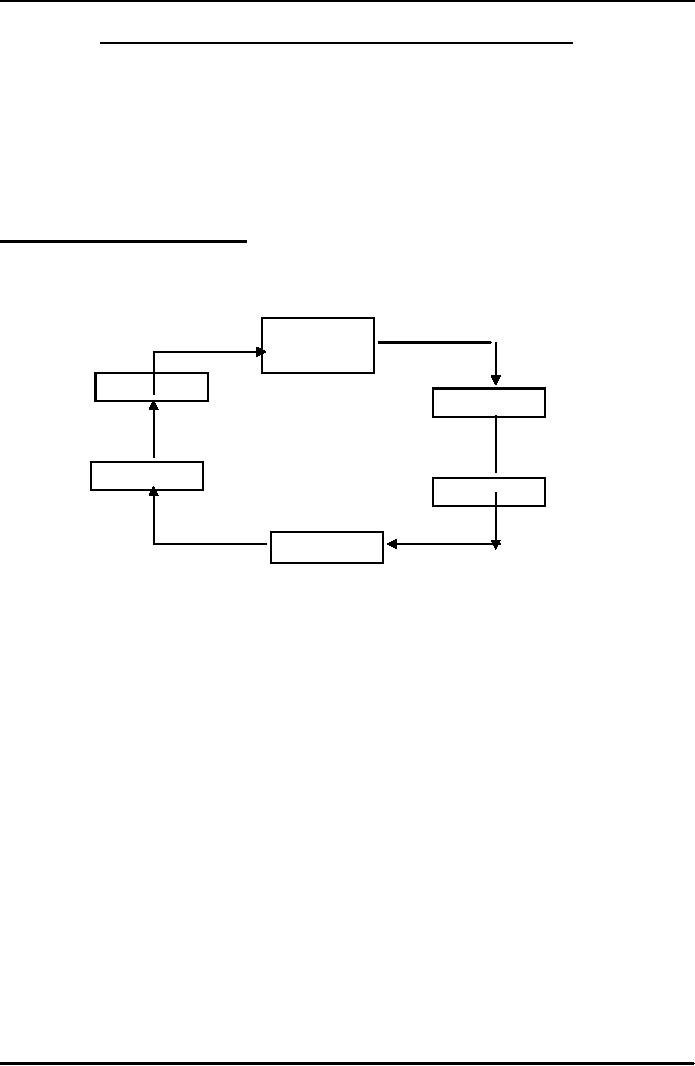 |

Change
Management MGMT625
VU
Lesson
# 44
CULTURE,
VALUES AND ORGANIZATIONAL
CHANGE
In
our earlier session, we had
examined that Burke Litwin
model and therein we had discussed
the
relationship
between performance and change by exploring the
interplay between organizational
functioning
and organizational desired goals. We also
talked about first-order
change or transactional
change
and compare it with second-order change
or transformational change. We had also
discussed
that,
only in OD framework we have large number
of models for organizing and maintaining
the
organizations
in today's complex business
environment. Similarly in today's
session, first we go
for
discussing
a new `Marvin Weisbord's
Six-box Model' and then we go
over to discuss
Culture,
Values
and Organizational Change.
Marvin
Weisbord's Six-Box Model
It
is a diagnostic frame work, as to
Burke Litwin model, often
used for diagnosing
organizational
problems
since 1976 when it
published. This model,
according to Weisbord, is based on
following
critical
areas:
Purposes
Leadership
Structure
Relationships
Rewards
Helpful
So
far we have dealt with
different variables in various
sessions with greater detail and
depth. The
purpose
of introducing variety is increasing our
understanding. The purpose of
introducing this
model
is to diversify the students' frame of
mind with greater verity of
tools for cognitive
mapping
and
systematic examining the processes and
activities in various models for
identifying gray areas
in
organizations.
Organizational
Culture, Values and Change
Management Process
Why
values are so much critical in
understanding change formulation and
execution? How
managers,
especially
top managers are able to
create the learning climate
for the enterprise? Or the question
is
whether
an organization can survive
without an appropriate set of values?
These are the questions
over
which a lot of research is
going on since early stages
of the evolution of modern
management
literature.
For instance, Emile Durkheim
(sociologist) worked on "values
and norms", Henri
Fayol's
work
on "social man" approach to management,
Vilfredo Pareto's work on "social
systems
approach"
and in the recent times
Peter F. Drucker's work on
"social environment." Therefore
over
the
period of time, beside the
scientific school of management we have
seen a progress in the areas
of
values,
norms, and in organizational culture
particularly in the context of developed
countries.
While
dealing with values one should
know that, values are not
the universal phenomena. These
have
been
varied across individuals, groups,
organizations and, of course, across
cultures. The value-
driven
organizations work out more
carefully in programming, evaluating and
executing the values as
to
form them into plan that
permeates everyday decisions. Koontz
defined the term "value"
as:
"A
fairly permanent belief about
what is appropriate and what is
not that guides the actions
and
behavior of employees in fulfilling the
organization's aims."
Enz
defined values as: "The
beliefs held by an individual or
group regarding means and
ends."
138

Change
Management MGMT625
VU
Other
scholars define values in various
terms such as:
·
in
terms of `beliefs'
·
in
terms of `actions, symbols'
·
and in
terms of social behavior and
norms
By
dealing with all these
definitions, we see that the
source of all values is human mind
that is based
on
perceptual construct or matrix which
evolves over a period of
time. This can be applied
to
multiple
levels of analyses. Another scholar
named Rokeach defined values at more generic
level as:
"Values
work to provide systems of
meaning and interpretation that
filter environmental and
intra-organizational
signals."
Here
in this definition we found
that, values drive peoples towards
sense making and therefore it
is
extremely
normal that different people
arrive or give different
meanings to a single phenomenon. It
is
because,
according to modern research context,
every individual is unique or
has unique
capabilities
and
hence his value
configuration and resource configuration
are also unique. Therefore,
according to
Rokeach,
values structure receives signals form
intra-organizational and environmental
levels,
interpret
them into new meanings or values, and
then prioritize them.
Significance
and Role of
Values
"Values
underpin the way in which
organizations are designed and operated
therefore
values
are embodied in organizations'
structures and system by
implication we have to
revise
our values instead of revision in
structures and
systems."
The
statement mentioned above shows
that values are built in
phenomena in organizations.
Nothing
is
value free or valueless at any
level of analysis. For instance, if an
organization goes for
introducing
technology
then this decision also
reflects values of a manager such as:
its belief on clean
processes,
efficient
control and modernity. So, the
imperative here is that, if
organization seeks change
then it
not
only needs revision in
strategy, structure, or technology but
needs a revision in values,
norms,
behaviors
and ultimately attitudes.
Most reforms failed in organizations
because of their focus
largely
on
visibles rather then on invisibles
like values and cultural
elements. For handling this
situation,
organizations
needs effective training
processes and transmission of new
knowledge and values for
changing
thought patterns.
While
dealing with values at environmental
level we study the relationship between
organizational
values
and the society. As Selznick, a well
known figure about
socio-technical system, noted
this in
1949
that:
"Organizations
are social systems"
He
believes that technological
development has greater impact on
social environment of a
society
and
technological organization itself
works in a society with some
social entity. Therefore,
organizational
values can never be considered
inalienable to its societal values. On the
other hand,
the
traditional Western scientific
management paradigm believed on
such inalienability and
indifference.
For instance, Max Weber, a German
intellectual, whose empirical
analyses of church,
government,
the military, and business led
him to the belief that
organization should be clear
about
rules,
definitions, tasks, and disciplines and
employees should work in politically and
socially neutral
ways
just like a machine. Therefore by
this way, he assumes
organizations will be more
productive.
This
seems to have very little
validity in the present times or
organizations will be faced up
with
serious
consequences.
At
individual level, it is historically
revealed that all humans
are emotional beings. Then
at
organizational
perspective this must also be
true that managers and
workers are also
emotional
beings.
Now, recent literature
suggests that managers are
not only intelligence and
emotional beings
139

Change
Management MGMT625
VU
but
also, one degree forward, are considered
spiritual being in line with
their value structure. And
on
the
basis of this value structure, the
degree of organization commitment is
determined. Similarly, the
organizations
are also exhibiting some
rationality in addition to profit
maximization. If organization's
values,
norms, and rationalities must be
compatible to the values, norms, and
rationalities of a society
then
this will allow least
interventions and regulations from
government otherwise large
interventions
and
regulations for organization. In
management discipline, we can
further discover this aspect
as
corporate
social responsibility concepts where
organizations are considered as corporate
social
citizens.
In the contexts of both entrepreneurship and
multinational corporations, the same
level of
value
alignment is required between values of an
entity and its
society.
Short
case
Suppose
there are two subordinates; one is
loyal but incompetent vs.
another, who is professional
but
arrogant
in behavior. The question
then is as an HR manager which one
would you wants to be
promoted
to the next higher management
tier? No matter what ever is
your decision, the fact
remains
that
values compete in your behavioral choice
or decision making process.
Therefore, in this
particular
case what is important is to
look is the fact that how
you prioritize your values.
Whether
these
are political or relationship
oriented values that stay at the
top in your preference as a
decision
maker
or otherwise. And as such there
exist a trade off between the two.
Most of the time
organizations
have to face such a trade-off
scenario like the one between
task orientation or
people
orientation
which comprises of participative
decision making versus
quality authoritative
decision
making.
Values
Compete
Choosing
an appropriate set of values is an art or
a challenge for change
management consultants,
strategists
and academicians because values most
often are also competing
with each other. A
scholar,
Quinn, who has been
engineered this concept into a
well-known paradigm entitled
as
Competing
Value Framework (CVF). It is an
assessment tool which
enables the higher
management
to
assess their current values
and help to transform them
into newly desired
ones.
In
organizations, we have different set of
values which shapes the norms,
conventions and cultures.
Most
often, the organizations would
deal with different
trade-off between various choices
like
between
task culture and support culture,
participative decision making and
unilateral decision
making,
and between quality and
quantity as we have seen in case
study. Then this must be
depend
upon
the priorities of the dominant culture
that how can organization
prioritize its values.
For
instance,
we have a very well familiar approach to
defining leadership styles is the Managerial
Grid,
where
a manager having concern
both for production and
for people. Through this
trade-off, it is easy
for
a manager to determine his compromised
leadership style. Similarly in
real life, there also
exists
number
of trade-off scenarios among various
values which compete with
each other.
How
these various kinds of
trade-off scenarios could be
resolved particularly in
organization
context?
The answer lies to the establishment of a
strong normative system which
means a system
which
could have the ability to sense
about good or bad. Without an
effective normative
system,
organizations
cannot move in the right direction. In
short, values are part of a normative
system
which
plays a decisive role in
organizational decision making and
communication. Unfortunately, we
can
observe that the normative
system is in weakening or declining in
this modern age. This
is
because
the information which is coming
from various channels is
diffusing or blurring our
view
about
good and bad. Therefore, we tend to have
a degenerating normative system.
Consequently, the
successful
organizations go for revisualization,
restructuring, reorganizing of values
known as
cultural
revitalization over a period of
time.
140
Table of Contents:
- COURSE ORIENTATION:Course objectives, Reading material, Scope of the subject
- BENEFITS AND SIGNIFICANCE OF CHANGE MANAGEMENT:Traditional management domain
- KURT LEWIN MODEL: ASSUMPTIONS AND IMPLICATIONS:Change Movement, Refreeze
- IMPLICATIONS OF KURT LEWIN MODEL:Sequence of event also matters, A Critical Look
- SOME BASIC CONCEPTS AND DEFINITIONS:Strategic change, Logical incrementalism
- TRANSACTIONAL VS. TRANSFORMATIONAL LEADERSHIP:Micro-changes, Organisation Development
- THEORIES OF CHANGE IN ORGANISATIONS
- LIFE CYCLE THEORY:Unit of Change, Mode of change, Organisation death
- TELEOLOGICAL THEORIES OF CHANGE:Unit of change, Mode of Change, Limitations
- DIALECTICAL THEORIES OF CHANGE:Unit of Change, Strategic planning
- A DIALECTICAL APPROACH TO ORGANISATIONAL STRATEGY AND PLANNING:
- LIMITATION OF DIALECTICS; DA AND DI:Overview of application of dialectics
- THEORIES OF CHANGE IN ORGANISATIONS
- APPLICATION OF EVOLUTIONARY THEORY:Managerial focus
- FURTHER APPLICATION OF EVOLUTIONARY THEORIES:Criticism
- GREINER’S MODEL OF ORGANISATIONAL– EVOLUTION AND REVOLUTION
- GROWTH RATE OF THE INDUSTRY:CREATIVITY, DIRECTION, DELEGATION
- COORDINATION:COLLABORATION, The Crisis
- ORGANISATION ECOLOGY:Structural Inertia, Internal Structural Arrangements, External Factors
- CLASSIFICATION OF ORGANIZATIONAL SPECIES:Extent of Environmental Selection, Determinants of Vital Rates,
- FOOTNOTES TO ORGANISATIONAL CHANGE:Stable Processes of Change, Rule Following, Conflict
- SOME COMPLEXITIES OF CHANGE:Superstitious Learning, Solution Driven Problems
- ORGANIZATIONAL ADAPTATION:The Entrepreneurial problem, The Administrative Problem
- PROSPECTORS:Analyzer, Reactors, Adaptation and Strategic Management
- SKELETAL MODEL OF ADAPTATION:Determinants of Adaptive ability, The Process of Adaptation
- STRATEGIC CHANGE:Nature of Change, The Importance of Context, Force field Analysis
- Management Styles and Roles:Change Agent Roles, Levers for managing strategic Change
- SYMBOLIC PROCESSES:Political Processes, COMMUNICATING CHANGE, Change Tactics
- STRATEGIC CHANGE:Pettigrew & Whipp’s Typology, Context on X-axis (Why of change)
- STRATEGIC CHANGE:Attributes of SOC Model, Implications for Management
- STRATEGIC CHANGE:Flow of Information, Recruitment, SOC Process
- Determinants of a Successful Change Management:Environmental, Management Orientation, Management Orientation
- Higgins 08 S Model – An Adaptation from Waterman’s Seven S model:Strategy, Systems and Processes, Resources
- IMPLEMENTATION AND STRATEGIC CHANGE: CONSTRAINING FORCES IN THE IMPLEMENTATION OF STRATEGIC CHANGE (CASE STUDY OF XYZ COMPANY)
- IMPLEMENTATION AND STRATEGIC CHANGE: CONSTRAINING FORCES IN THE IMPLEMENTATION OF STRATEGIC CHANGE (CASE STUDY OF XYZ COMPANY)
- WHY IMPLEMENTING STRATEGIC CHANGE IS SO DIFFICULT?:Change Typology, Technical Change
- IMPLEMENTATION APPROACHES:Attributes of incremental change,
- IMPLEMENTATION: RADICAL OR TRANSFORMATIVE CHANGE
- IMPLEMENTATION: RADICAL OR TRANSFORMATIVE CHANGE:Definition of Leadership, Follower Work Facilitation
- IMPLEMENTATION: RADICAL OR TRANSFORMATIVE CHANGE:Recognize the challenge
- IMPLEMENTATION: RADICAL OR TRANSFORMATIVE CHANGE
- IMPLEMENTATION: PUNCTUATED EQUILIBRIUM MODEL:Features of Radical Change, Theory of P-E model
- CHANGE IMPLEMENTATION: OD MODELS:The Transactional Factors
- CULTURE, VALUES AND ORGANIZATIONAL CHANGE:Significance and Role of Values, Values Compete
- ORGANIZATIONAL VALUES, CULTURE AND ORGANIZATIONAL CHANGE:Issues in Change Management